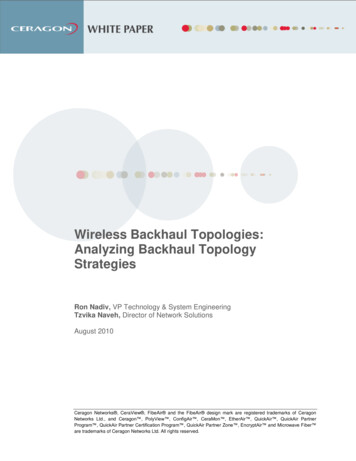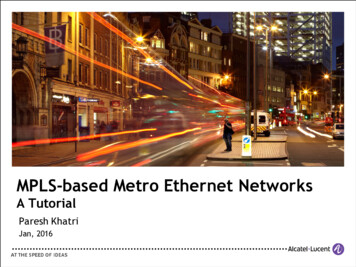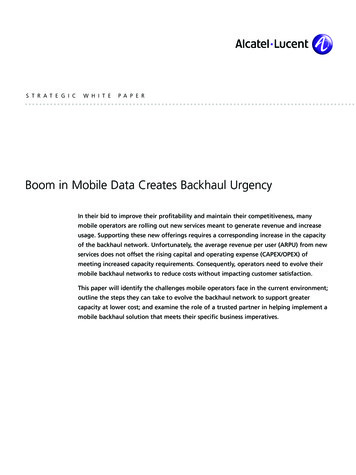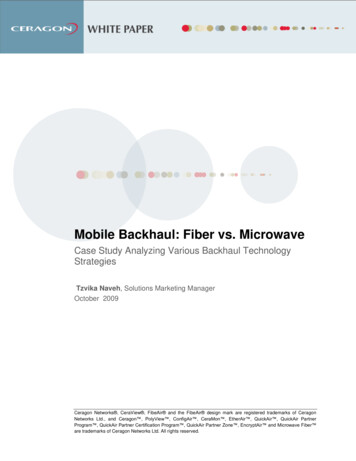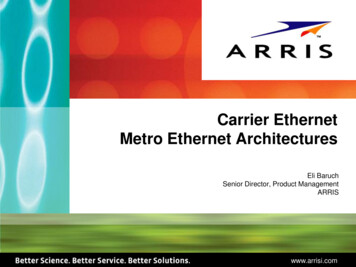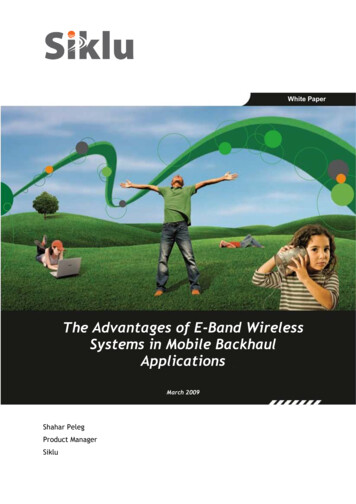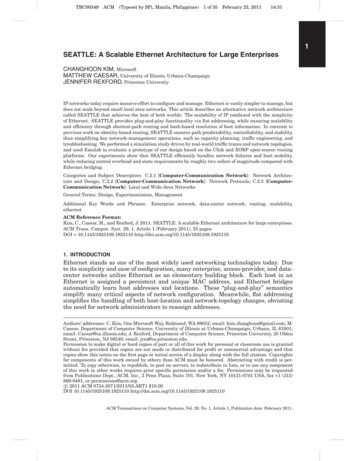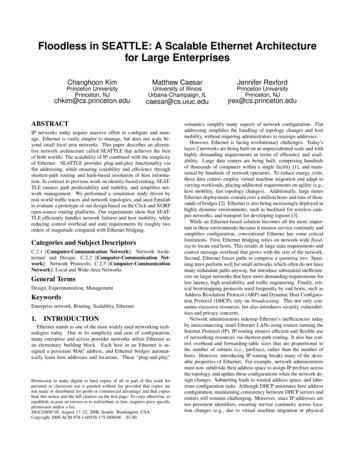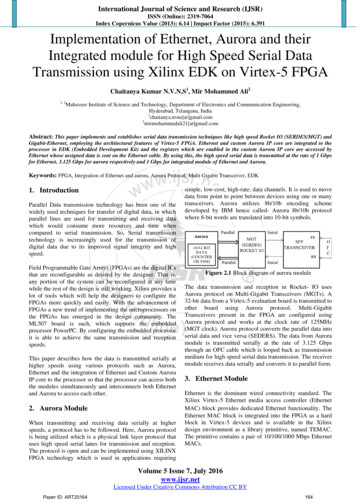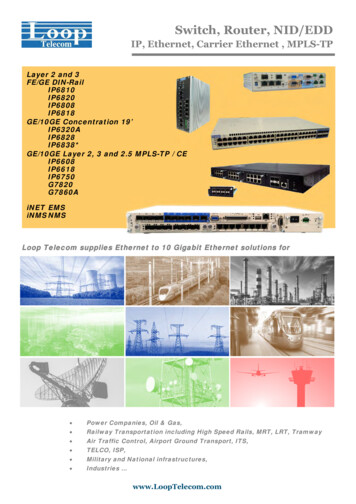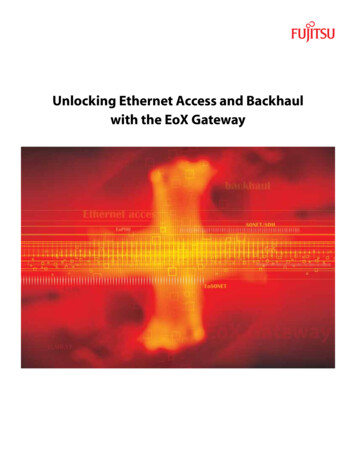
Transcription
Unlocking Ethernet Access and Backhaulwith the EoX Gateway
Ethernet has become the most popular interface to attachend users and access devices to the range of Ethernet and IPnetwork services. This simple, low-cost, familiar technology iseasy for end users to own and operate. A single Ethernet jackcan support multiple connections and a wide range of accessbandwidths, thus enabling end users to grow connectivity andbandwidth easily as needed. Ethernet services are often pricedmore inexpensively per unit bandwidth than legacy TDM-basedservices. With the emergence of COE, Ethernet now promises thesame reliability, performance, and security of SONET/SDH, butwith the low network cost and bandwidth flexibility inherent toEthernet.The ChallengesProviders face complex economic and networking challenges asthey work to offer Ethernet-attached services to their customers.These challenges are inherent to access and backhaul networks,and they restrict the scale, cost-effectiveness and velocity atwhich Ethernet-attached services can be deployed.Diverse Access NetworksConnection-Oriented Ethernet (COE) usingEthernet Tag Switching brings advancedtraffic engineering capabilities to CarrierEthernet. Connection-Oriented Ethernetaccomplishes for Ethernet what SONETtechnology accomplished for DS1s and DS3sby enabling network providers—for thefirst time—to deploy a single, long-lastingEthernet infrastructure for all Ethernet privateline and access/backhaul applications.By invoking per-flow traffic engineering,resource reservation and connectionadmission control along with the latestEthernet OAM and protection standards,COE delivers the performance, reliability andsecurity of SONET/SDH networking, whileretaining the networking efficiency of nativeEthernet networking. To read more aboutCOE, please see the Fujitsu white papers,“Connection-Oriented Ethernet – Completingthe Ethernet Revolution”, and “ConnectionOriented Ethernet – Operational andDeployment Considerations”For access and backhaul networks, the technology choice isoften driven by the cost of the specific deployment, which can drive network providers to rely on a complexmix of technologies such as optical Ethernet, EoS, EoPDH, or Ethernet over OTN. This access environment maybe owned or leased by the provider. Each of these networks may employ different transport layer functions,including encapsulations, OAM methods, and protection protocols.Complex Service and Transit Network HandoffsThe overall solution for delivering Ethernet-attached services often involves multiple networks owned byone or more providers. The access and backhaul provider is then responsible for terminating the variousaccess networks and delivering a standard handoff to a network or transit network, each of which may use adifferent technology, have its own set of handoff requirements and may be operated by a different businessentity.The combined challenges of diverse access networks and complex service and transport handoffs, togetherwith the presence of multiple business entities, creates an expensive and complex networking problem athub offices where these environments collide. This problem is typically addressed in a brute-force mannerby deploying multiple types of elements including MSPPs, EoPDH termination boxes, Ethernet switches andDCS platforms that perform the various required Layer 1 and Ethernet layer termination and encapsulationfunctions. This approach results in much additional cost.FUJITSU NETWORK COMMUNICATIONS INC.2801 Telecom Parkway, Richardson, Texas 75082-3515Telephone: (972) 690-6000(800) 777-FAST (U.S.)us.fujitsu.com/telecomFor your convenience, a list of acronyms can be found at the end of this document.1
orkEoXGatewayEthernetoverEthernetSONET/SDH over /SDH/OTNNetworkEthernetover PDH(over SONET/SDH)Ethernetover PDHAccessTransitNetworksAccessand BackhaulNetworksEnd identialBroadbandaccessFigure 1: EoX Gateway Simplifies Hub Offices by Interconnecting Access and Backhaul Networks toService and Transit NetworksAs shown in Figure 1, the EoX Gateway eliminates multiple elements by terminating the diversity of accessnetworks and presenting a flexible variety of handoffs to the full range of service and transit networks. Byconverging multiple access networks, EoPDH, EoSONET, and native Ethernet onto a single EoX Gatewayelement, substantial network cost savings and network element reduction can be achieved, as shown inFigure 2.FUJITSU NETWORK COMMUNICATIONS INC.2801 Telecom Parkway, Richardson, Texas 75082-3515Telephone: (972) 690-6000(800) 777-FAST (U.S.)us.fujitsu.com/telecom2
8Normalized Cost Comparison –EoX Gateway vs. PMOHub Site Systems - PMO Vs.EoX GatewayNormalized 28256MSPPsNumber of Ethernet UNIsEthernetEoPDH SwitchesGatewaysPacketONPFigure 2: Example Cost savings and Element Reduction of EoX Gateway Versus Present Mode of Operation (PMO)The EoX Gateway serves many important applications, includingwholesale Ethernet access service, retail Ethernet and IPservices access, mobile backhaul, and DSLAM backhaul. Thispaper describes the EoX Gateway functions that leverage theintegration of Layer 1 networking and COE that define PacketONPs, facilitating cost-effective and scalable access and backhaulof Ethernet-attached services.The EoX GatewayA Packet ONP configured as an EoX Gateway sits among theaccess, transit, and service networks. The EoX Gateway providesa range of both optical transport layer and Ethernet service layerfunctions, as shown in Figure 3.Packet Optical Networking Platforms(Packet ONPs) integrate traditional layer1 optical networking such as SONET/SDHand photonic networking with ConnectionOriented Ethernet. An “open platform” PacketONP implementation enables networkproviders to create a universal aggregation,transport, and private line servicesinfrastructure that equally serves Ethernetand traditional TDM networking needs. Toread more about Packet Optical Networking,please see the Fujitsu white paper, “PacketOptical Networking Platforms - Delivering theConnected Experience”The transport functions encompass more than just physicallayer termination. They can include complete transport network termination: physical layer termination,protection switching and protocol termination, Ethernet encapsulation, and OAM. Since these transportfunctions are isolated on each side of the Gateway, the EoX Gateway will often provide many instances oftransport network termination for many different technologies.The Ethernet service functions flow across both sides of the Gateway and are the same regardless of theunderlying transport network. The EoX Gateway is responsible to assure the integrity of the Ethernet service,especially CoS marking, QoS management, and OAM, across disparate transport networks and businessentities.FUJITSU NETWORK COMMUNICATIONS INC.2801 Telecom Parkway, Richardson, Texas 75082-3515Telephone: (972) 690-6000(800) 777-FAST (U.S.)us.fujitsu.com/telecom3
Figure 3 depicts the network-to-network interface (NNI)—the demarcation and handoff point betweencommercial entities on the “service/transit network” side of the EoX Gateway. In this case, the access provideris responsible for access network termination and creating the acceptable handoff to the service network.EoX GatewayNNIQoSAccess/BackhaulNetworkEthernet ServiceFunctionsOAM (FM/PM)EncapsulationNetwork protectionPhysical layer TransitNetworkNetwork protectionPhysical layer terminationFigure 3: EoX GatewayEoX Gateway Transport FunctionsThe EoX gateway is responsible for terminating a wide variety of transport network technologies, includingEthernet over SONET/SDH, Ethernet over PDH over SONET/SDH, and native Ethernet.For Ethernet-attached services, both non-routed optical Ethernet and SONET/SDH access technologieswill remain in use for the next several years for simple economic reasons. Tens of thousands of SONET/SDHsystems are deployed at customer premises locations and are being leveraged for transporting Ethernet.This is because the cost of deploying an Ethernet port on those systems is far less than capitalizing andmanaging an additional access element and an additional fiber pair.SONET/SDH systems remain in use for Ethernet access where the end-user attaches to the access networkwith an Ethernet over PDH system to the fiber access point and a SONET/SDH network transports the PDHcircuits to the service edge. This results in the requirement for a multilayer Ethernet over PDH over SONET/SDH network termination at the EoX Gateway.Increasingly, native Ethernet access networks are being deployed with different physical layers, protectionschemes, and tagging options.The EoX Gateway is deployed at homing points for the access and backhaul networks, where it providesthe termination of the physical layer, its associated framing and physical layer OAM. The EoX Gateway alsoperforms the more complex functions of: Operating the protection switching protocol toward the access network De-encapsulating Ethernet traffic from its physical layer transportFUJITSU NETWORK COMMUNICATIONS INC.2801 Telecom Parkway, Richardson, Texas 75082-3515Telephone: (972) 690-6000(800) 777-FAST (U.S.)us.fujitsu.com/telecom4
TDM ProtectionFor access networks that use Ethernet over SONET/SDH and Ethernet over PDH (over SONET/SDH), theprotection protocol exists at the SONET/SDH layer and is well understood. In the typical homed backhaulring environments, UPSR/SNCP higher order and lower order protection is the prevalent architecture, alongwith some deployment of 1 1 line layer/multiplex section layer protection for point-to-point access.Ethernet ProtectionSeveral existing or emerging Ethernet protection technologies are better suited to access networks thanlegacy IEEE 802.1 spanning tree-based approaches. These technologies include ITU-T G.8031 Ethernet LinearProtection Switching, and IEEE 802.1AX link aggregation protocols.While link aggregation is standardized over point-to-point configurations only, G.8031 protection achieves50 ms protection switching speed over any physical topology, including the homed-ring topologies thatare prevalent in access environments. G.8031 provides a dedicated protection path with identical resourcesto the working path. In the event of node, link, or connection failures, a simple APS protocol provides 50 msswitching to the protection resources, as illustrated in Figure 4.Working ure 4: G.8031 End-to-End Protection IllustrationG.8031 offers several advantages. It provides both end-to-end and segment protection (Figure 5), so thatthe backhaul network can be protected independently from an attached service or transit network. Italso protects multiple connection tunnels simultaneously and provides protection regardless of how theEthernet frames are tagged.FUJITSU NETWORK COMMUNICATIONS INC.2801 Telecom Parkway, Richardson, Texas 75082-3515Telephone: (972) 690-6000(800) 777-FAST (U.S.)us.fujitsu.com/telecom5
ProtectionDomainNationalTransit NetworkPProtectionDomainWWNIDPPWMetro/Access #1Metro/Access #2ProtectionDomainNIDFigure 5: G.8031 Segment Protection Guards Against Multiple FailuresEthernet over TDM EncapsulationsA variety of Ethernet over PDH and SONET/SDH encapsulations have been employed in conjunction withvarious virtual concatenation approaches that enable access providers to offer a range of bandwidth overa variety of available physical networks. While the technology for encapsulating Ethernet over a variety ofTDM networks is well understood, the sheer breadth of encapsulations in the field represents a significantnetworking challenge.Common optical access encapsulation options include: Ethernet over X.86 over DS3/E3 over SONET/SDH Ethernet over X.86 over STS-1/VC-4 Ethernet over X.86 over DS1/E1 VCAT group over SONET/SDH Ethernet over X.86 over VT1.5/TU11 Ethernet over GFP over STS/VC-4 VCAT group Ethernet over GFP over VT1.5/TU11 VCAT group Ethernet over GFP over STS/VC-4 VCAT group Ethernet over GFP over DS1/E1 VCAT group over SONET/SDH Ethernet over GFP over DS3/E3 VCAT group over SONET/SDHEthernet Encapsulation and Tagging ConsiderationsIn addition to the physical layer encapsulation issues that exist with TDM-based access, the EoX Gatewaymust enable a variety of Ethernet tag encapsulation permutations. These Ethernet tagging considerationsapply when Ethernet traffic is being transported not only over an optical Ethernet network, but also overa SONET/SDH or backhaul network to the EoX Gateway. There are several examples of interest as shown inFigure 6.FUJITSU NETWORK COMMUNICATIONS INC.2801 Telecom Parkway, Richardson, Texas 75082-3515Telephone: (972) 690-6000(800) 777-FAST (U.S.)us.fujitsu.com/telecom6
Service-awareNIDEoX GatewayS-tagged framesUNIS-tagged framesTranslationEthernet ice-awareNIDEoX GatewayS-tagged framesUNIS-tagged framesSwitchingAccess/BackhaulNetworkb)EoX GatewayMediaConverter/EoSC-tagged,untagged -tagged framesTranslationPush, popEthernet Service/TransitNetworkEoX GatewayS-tagged framesUNId)Ethernet ServiceNetworkAccess/BackhaulNetworkS-tagged framesTranslationPush, popEthernet TransitNetworkFigure 6: Ethernet VLAN Tagging/Encapsulation PermutationsFUJITSU NETWORK COMMUNICATIONS INC.2801 Telecom Parkway, Richardson, Texas 75082-3515Telephone: (972) 690-6000(800) 777-FAST (U.S.)us.fujitsu.com/telecom7
In many cases (Figure 6a), the Ethernet UNI does not exist on the EoX Gateway, but is provided by aremote service-aware Ethernet NID, close to the end-user location. This remote NID will be responsible forencapsulating the customer Ethernet frames into a service-provider tagged (S-tagged) Ethernet frame. Inthese cases, the EoX Gateway recognizes and forwards S-tagged frames, potentially performing an S-tagtranslation depending upon the destination network requirements.One important variation (Figure 6b) is where different business entities operate the access network andthe Ethernet service network. In this case, the optical access network provides a UTAS between a NID thatimplements a remote UNI (RUNI) function and the edge device in the Ethernet service network, connectedto EoX Gateway that implements a virtual UNI (VUNI) function. The NID encapsulates each of the enduser’s individual EVCs into a single S-VLAN tag by performing all-to-one bundling, before it forwards thoseEVCs towards the EoX Gateway. This S-VLAN tag is preserved as it passes through the EoX Gateway and isterminated (popped) on the edge device in the Ethernet service network that implements the VUNI.Similarly, the edge device encapsulates one of the customer’s EVCs into a single S-VLAN tag, before itforwards those EVCs towards the EoX Gateway. The S-VLAN tag is preserved as it passes through the EoXGateway and is terminated (popped) on the NID. This, in essence, creates a bidirectional “tunnel” betweenthe NID and the edge device in the Ethernet service network. One such tunnel exists for each NID in theoptical access network. The EoX Gateway is not service-aware, and is only aware of the S-tagged tunnel. Theremaining network elements in the optical access network may also not be service-aware. The benefit of thisapplication is that the Ethernet service provider can create multiple EVCs without repeated interactions withthe access provider.In other cases (Figure 6c), the remote NID device or Ethernet over SONET/SDH access device is not serviceaware and only provides simple media conversion or Layer 1 encapsulation. In these cases, the EoX Gatewayfunction may be called upon not only to translate S-tag values, but also to push/pop S-tags onto Ethernetframes into and out of the optical access network.Another permutation (Figure 6d) exists when the EoX Gateway sits at the boundary between an opticalaccess network and a transit network. In this case, the EoX Gateway will often receive an S-tagged Ethernetconnection from the access network, but because the transit network forwards traffic based on a secondlayer of S-tag, the EoX Gateway is required to push a second S-tag in the access to transit direction and popthat second tag in the reverse direction. Optionally, inner or outer S-tag translation may be required.FUJITSU NETWORK COMMUNICATIONS INC.2801 Telecom Parkway, Richardson, Texas 75082-3515Telephone: (972) 690-6000(800) 777-FAST (U.S.)us.fujitsu.com/telecom8
EoX Gateway Ethernet Service FunctionsThe EoX Gateway must provide Ethernet service layer functions of CoS marking, QoS management, andEthernet service OAM. The exact Ethernet service layer functions required vary according to the type ofservice, access or transit network that is involved and whether or not that network is Ethernet service-aware.Common combinations of services and network types include: E-Line services delivered over either service-aware or service-unaware Ethernet over SONET/SDH orEthernet over OTN networks E-Line services delivered over service-aware native Ethernet or MPLS networks E-LAN Ethernet services delivered using IEEE 802.1ah or 802.1ad bridged networks. E-LAN Ethernet services delivered using IETF VPLS IP services such as internet services or “IP VPN” services delivered over IP/MPLS networksThe MEF ENNI specification is currently scoped to describe the attributes at the physical and Ethernet servicelayers at an NNI that uses an Ethernet physical layer to connect two Ethernet-aware networks that areproviding actual Ethernet services (as opposed to IP services).Handoffs of Ethernet connections over general NNI interfaces (beyond the scope of the current MEF ENNIspecification) are deployed and of interest for EoX Gateway applications. Examples of such handoffs includecases where non-Ethernet physical layers are used and cases where Ethernet connections are handed off toIP services networks or to transit networks that are not Ethernet service-unaware.CoS MarkingSince the Ethernet service layer is exposed at the EoX Gateway, the Gateway is responsible, as necessary,for properly mapping and interworking CoS marking across the relevant network boundaries. Consider acase where an access network provider may use four classes of service, while the Ethernet service networkprovider may use only three. The providers must agree how to map one class into another. Accordingly, thePCP marking in the Ethernet service frames may have to be modified or translated by the EoX Gateway.Figure 7 illustrates the EoX Gateway performing PCP modification in case of a) an ENNI interface, and b) anon-Ethernet NNI interface. For the ENNI interface, as shown in Figure 7a, the EoX Gateway is responsiblefor PCP translation upon egress from one network to another. Therefore, EoX Gateways on either side of theENNI perform PCP translation.In more complicated cases as shown in Figure 6b, a single EoX Gateway on one side of the NNI may have toprovide PCP translation in both directions of an EVC. There may be, for example, a non-Ethernet-aware transitnetwork in between an Ethernet-aware access network and an Ethernet-aware service network. It may be ofvalue for an EoX Gateway at one side of the NNI to perform PCP translation in both directions of the EVC. Inthis way, the access network operator can ensure correct PCP marking in cases that are not currently coveredby industry specifications.FUJITSU NETWORK COMMUNICATIONS INC.2801 Telecom Parkway, Richardson, Texas 75082-3515Telephone: (972) 690-6000(800) 777-FAST (U.S.)us.fujitsu.com/telecom9
PCP translationPCP translationENNIPCP translationNNIAny TransportLayerEth transport layerEoXGatewayAny TransportLayerEoXGatewaya) ENNI handoffAny TransportLayerAny TransportLayerEoXGatewayb) Non-ENNI handoffFigure 7: PCP Translation in the EoX GatewayThe MEF 23 specification also describes requirements for maintaining the appropriate color marking forEthernet service frames that transit an ENNI. Specifically, the ENNI must be color-aware if any of the UNIsin the service are color-aware and the ENNI must be able to appropriately handle inconsistencies betweencolor-aware and color-blind networks. For example, “yellow” frames cannot be inadvertently promoted to“green” frames across the ENNI. One implication of this is when “yellow” frames are exiting a color-awarenetwork to a color-blind network, an EoX Gateway at the color-aware network egress would be required todiscard yellow frames rather than passing them to the color-blind network as-is or re-marking the frames asgreen.QoS ManagementThere are several policing and shaping traffic management functions that are invoked for QoS managementat the EoX Gateway, depending upon the types of networks that are being joined together.Policing is invoked at the ingress to a network at a UNI or NNI. Upon egress to another network, policingis invoked at an NNI. Shaping functions are used on egress from a node to ensure QoS as traffic flows intonetworks that are either not service-aware or for performance reasons do not invoke ingress policing.The MEF 10.1 and ENNI specifications indicate two-rate, three-color policing algorithms to enforce thebandwidth profile attributes of Ethernet connections. These algorithms can be invoked at the port level,EVC level, or CoS instance level (within an EVC), according to the manner in which the bandwidth profileis specified. Similarly, hierarchical egress traffic shaping at the port, EVC, and CoS instance ensures that thelatency-sensitive, strictly priority-queued frames are not overscheduled and therefore neither exceed theirbandwidth allocation on egress nor starve out lower priority frames.FUJITSU NETWORK COMMUNICATIONS INC.2801 Telecom Parkway, Richardson, Texas 75082-3515Telephone: (972) 690-6000(800) 777-FAST (U.S.)us.fujitsu.com/telecom10
Several possible scenarios are available for the EoX Gateway to invoke these functions, depending uponwhether or not the attached networks are Ethernet service-aware and whether the EoX Gateway is deployedat the boundary between network operators or at a transport network boundary within a single-operatordomain.The simplest case is where an EoX Gateway is deployed at a boundary between two different Ethernet-awarenetworks in the same provider domain. In this case, ingress policing functions are performed at the UNIson ingress to each network and the EoX Gateway merely shapes traffic as it passes from one domain to theother.In many cases, though, the optical access network is SONET/SDH (or PDH over SONET/SDH) and may not beEthernet service-aware. In these cases, the EoX Gateway is responsible for performing policing on behalf ofthe non-service-aware network as well as shaping between networks, as shown in Figure 8. An extensionof this application is where both networks are not service-aware (for example, one network is SONET/SDHaccess and the other is an OTN transit network) and the EoX Gateway performs both ingress policing andegress shaping in both directions for all EVCs.EoX GatewayPolicingNon-service awarenetwork AShapingShapingUNIEthernetservice-awarenetwork BPolicingFigure 8: Ingress Policing on Behalf of Non Service-Aware Access NetworksOf further interest are cases covered by the current work of the MEF ENNI specification, as shown inFigure 8. In these cases, the EoX Gateway sits at a boundary between two Ethernet service-aware networks.It is required to invoke both ingress and egress policing functions at the boundary, to enforce the ingressand egress bandwidth profile attributes required by the specification. Although not explicitly required bythe specification, shaping in the Gateway is also of value for this application.FUJITSU NETWORK COMMUNICATIONS INC.2801 Telecom Parkway, Richardson, Texas 75082-3515Telephone: (972) 690-6000(800) 777-FAST (U.S.)us.fujitsu.com/telecom11
EoX GatewayEgressPolicingIngressPolicingEthernet serviceaware network AENNIEthernet-serviceaware network BFigure 9: Ingress and Egress Policing at the ENNIFinally, there are many cases where an optical access network provides Ethernet access for IP VPNservices. If the optical access network and the IP service network are operated by the same provider, theservice provider can achieve substantial improvement in IP router packet throughput performance. Thisimprovement results from providing egress shaping in the EoX Gateway and not invoking ingress policing inthe provider edge router, as shown in Figure 10.EoX GatewayEgressShapingEthernet accessnetworkIP VPNnetworkFigure 10: Egress Shaping at the EoX Gateway Improves PE Router Performance for IP ServicesEthernet OAMIn many cases, the interconnection of optical access networks with transit or services networks may occuracross business entities. In these cases, the EoX Gateway employs service OAM functionality at the Ethernetservice layer to meet the required demarcation functionality.There are two key OAM standards for Ethernet fault and performance management: ITU-T Y.1731 and IEEE802.1ag. In addition, MEF ENNI specification describes how to apply these standards in various networkscenarios that involve Ethernet-aware networks that deliver Ethernet services.FUJITSU NETWORK COMMUNICATIONS INC.2801 Telecom Parkway, Richardson, Texas 75082-3515Telephone: (972) 690-6000(800) 777-FAST (U.S.)us.fujitsu.com/telecom12
Y.1731 has defined multiple OAM layers, as well as endpoint and intermediate-point functions known as MEPand MIP functions respectively. An example service OAM architecture applied to an MEF ENNI is shown inFigure 11.Figure 11: ENNI Service OAM Reference DiagramThe EoX Gateway at elements 4 and 5 will include operator layer MEP functions to provide fault andperformance management within each particular operator domain. Additionally, the draft MEF ENNIspecification requires EVC layer MIP functions, so that each operator can perform basic fault sectionalizationto the other side of the ENNI demarcation. There are also requirements for down MEPs at the ENNI ME layer.As discussed before, there are many cases where the optical access network will interface to a transitnetwork or a non-Ethernet, service-unaware network. In these cases, since the EoX Gateway is deployed ononly one side of the NNI, other permutations of 802.1ag and Y.1731 may be required. Figure 11 shows oneexample where EoX Gateways connect an access network and a service network, both owned by the sameoperator, to an intervening transit network owned by a different operator. In this case, the EoX Gatewaysperform both MEP and MIP functions for fault and performance management. The EoX Gateway may alsobe responsible to propagate faults, using the AIS function described in Y.1731. This fault propagation canoccur either at an individual EVC granularity or at the S-tag tunnel granularity, depending on the networkarchitecture. To read more about Ethernet Service OAM in general, please see the Fujitsu white paper,“Ethernet Service OAM: Overview, Applications, Deployment, and Issues” available from the Fujitsu Website.FUJITSU NETWORK COMMUNICATIONS INC.2801 Telecom Parkway, Richardson, Texas 75082-3515Telephone: (972) 690-6000(800) 777-FAST (U.S.)us.fujitsu.com/telecom13
EoX GatewayNNINNIEoX GatewayEthernet unawareTransit networkUNIOptical accessnetworkEVC MEEVC MEUNIServicenetworkMEPMIPFigure 12: EoX Gateway OAM Functions for a Transit Network ApplicationEoX Gateway ApplicationsImportant Ethernet applications for the EoX Gateway include wholesale and retail Ethernet accessservices, mobile backhaul networks, and DSLAM backhaul networks, shown briefly in Figures 13, 14, and 15respectively.In each of these applications, there is a need to terminate multiple access and backhaul transporttechnologies, create handoffs to service and transit networks—often operated by different business entities—and maintain Ethernet service, CoS, QoS, and OAM across these discontinuities.FUJITSU NETWORK COMMUNICATIONS INC.2801 Telecom Parkway, Richardson, Texas 75082-3515Telephone: (972) 690-6000(800) 777-FAST (U.S.)us.fujitsu.com/telecom14
ENNIHub COPacketONPEoXGatewayOff-netCOESONETT1, T3PacketONPEoTDMEthernetNIDMSPPFigure 13: Wholesale and Retail Ethernet Access Service Solution with EoX Gateway at Hub ingCOE overSONET RingNIDPacketONPNative EthernetEoX GatewayFigure 14: Full-Service Mobile Backhaul with EoX Gateway at Mobile Switching OfficeFUJITSU NETWORK COMMUNICATIONS INC.2801 Telecom Parkway, Richardson, Texas 75082-3515Telephone: (972) 690-6000(800) 777-FAST (U.S.)us.fujitsu.com/telecom15
EoXGatewayHub COPacketONPCOE SONET RingDS3ATM DSLAMPacketONPPacketONPGEIP DSLAMDS3GEATM DSLAMIP DSLAMFigure 15: SONET and Connection-Oriented Ethernet DSLAM Backhaul Network with EoX Gateway at Hub OfficeSummaryEthernet has become the most popular interface to attach end users and access devices to the range ofEthernet and IP network services. With the emergence of COE networking, Ethernet now promises to beable to deliver the reliability, performance, and security of SONET/SDH, but with the low cost and bandwidthflexibility inherent to Ethernet.For many applications, a service provider delivering these Ethernet attached services must deploy multipleaccess network technologies, and deliver a varied set of handoff interfaces to service and transit networksthat may be operated by different business entities.The combined challenges of access network diversity, service and transport network handoff complexity,and the presence of multiple business entities creates an expensive and complex networking problem athub offices where these environments collide.T
please see the Fujitsu white paper, "Packet . SONET/SDH systems remain in use for Ethernet access where the end-user attaches to the access network with an Ethernet over PDH system to the fiber access point and a SONET/SDH network transports the PDH circuits to the service edge. This results in the requirement for a multilayer Ethernet over .
